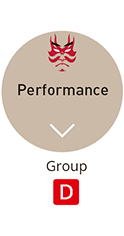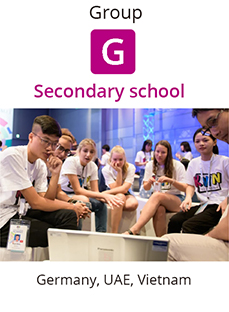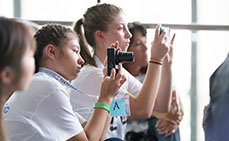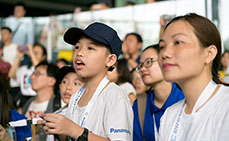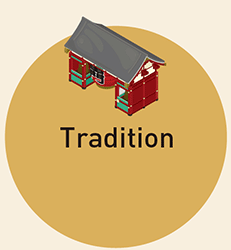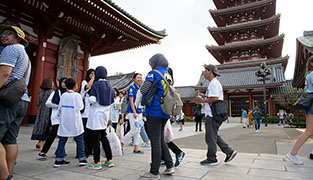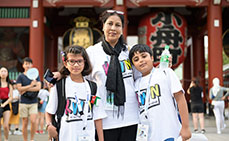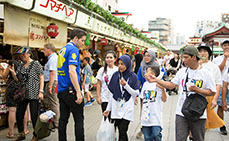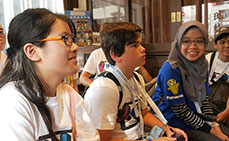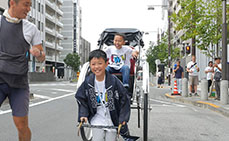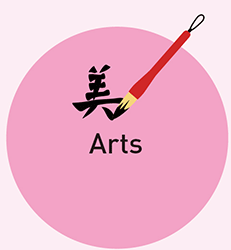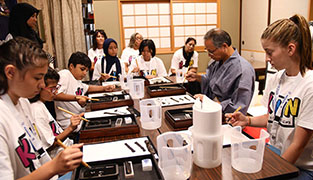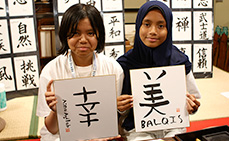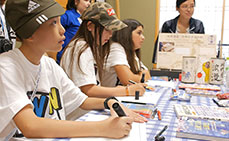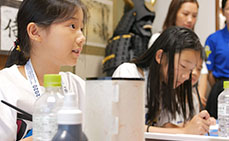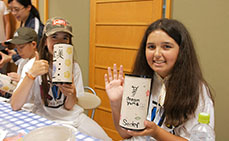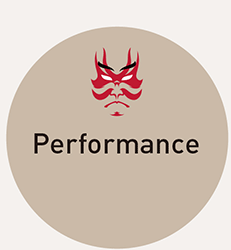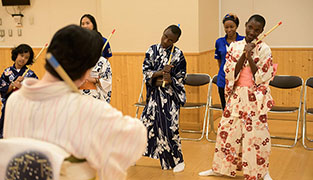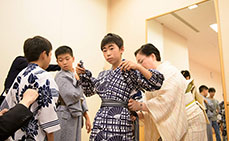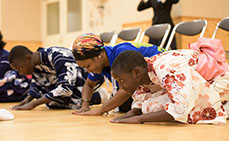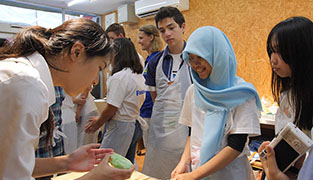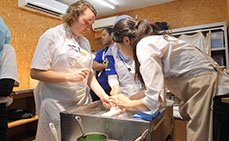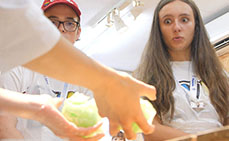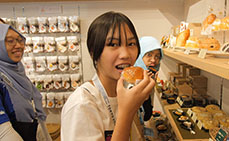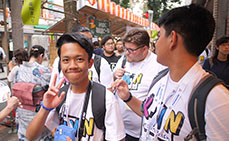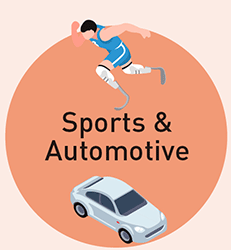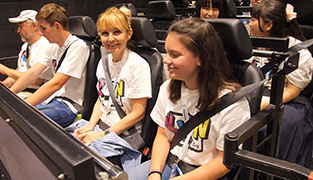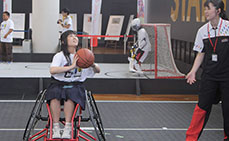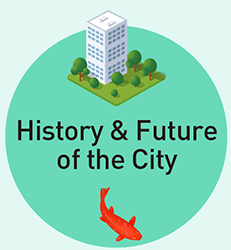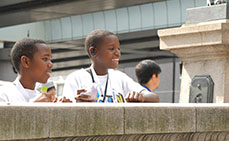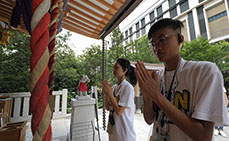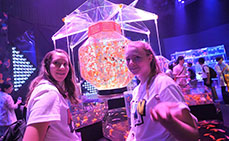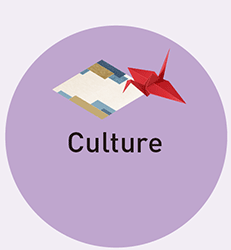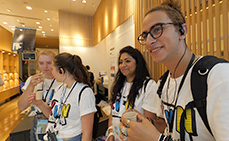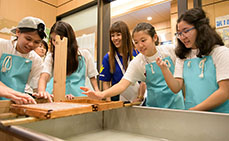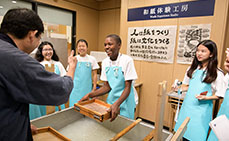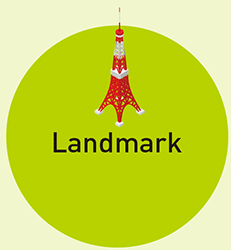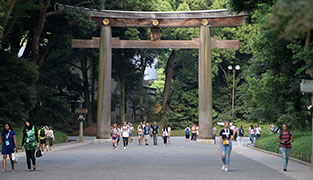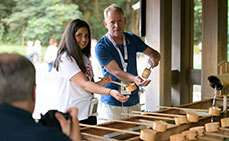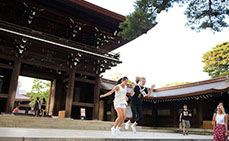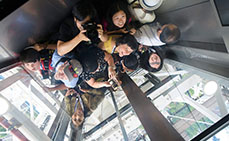

A national science museum within the Tokyo Academic Park, born as a center for deepening the understanding of science and technology.
At Miraikan, the kids learned about the world from a scientific viewpoint, and had fun interacting with a recently developed Japanese robot. Can people and robots coexist? What are the most important things for creating a "Better Future?" The kids were filled with ideas for their discussion the following day.


Part of Tokyo's "old town" with all the charm of the Edo Period, symbolized by the Kaminarimon Gate and Sensouji Temple. That's what makes it popular with both Japanese and overseas visitors.
In contrast with the image of Tokyo's cutting-edge surroundings and technologies, Asakusa preserves the feeling of Japan's olden days. The kids visited Sensouji Temple and Nakamise street, one of the oldest shopping centers in Japan.
And, Rickshaw drivers, who know all there is to know about Asakusa, also provided a rickshaw experience with lots of info about the area, its history, and its surroundings.


A variety of Japan's traditional arts can be experienced in the wonderful surroundings of Asakusa. Foreign tourists are also fond of hands-on classes where they can learn calligraphy, the tea ceremony, glasswork, and Japanese sweets.
The kids enjoyed experiencing calligraphy and writing onto lanterns. Calligraphy taught them the basics of using a brush, ink, and Japanese paper, and they were able to write whatever they wanted with Kanji characters.
In the days when lighting came mainly from candles or oil, people used lanterns in their homes. The kids enjoyed making their own original lanterns, using Japanese paper and any words or pictures they wanted.


The first Kabukiza opened in 1889. It also included a gallery where people from other countries could comfortably enjoy the world of Kabuki.
Backed by about 400 years of history, Japan's Kabuki is universally attractive because of its beautiful style, its graceful manner, and its unique makeup. The kids were able to experience the practice of the Kabuki performers. After learning the strict manners, they were also able to challenge an actual performance.



Realistic-looking food samples first became used as Japanese promotional tools from the Taisho era (starting in 1912) to the early Showa era (starting in 1926). They are now drawing attention as an art form in other countries.
Colorful examples of food are lined up in glass cases outside Japanese restaurants. These are actually carefully crafted models of the food that is served there. The kids were able to experience making these "food samples." Using wax, craftsmen reproduce these dishes so they appear just like actual food. The kids prepared samples of food such as shredded cabbage and tempura.
Following this, the kids observed a Japanese festival to enjoy Japanese culture in traditional neighborhoods.


MEGAWEB is a display showroom and theme park operated by Toyota Motor Corporation. It consists of a variety of content, including a zone where visitors can see and use advanced technologies, and a zone where everyone can experience Paralympic Sports, which Toyota supports.
Here, the kids were able to challenge floor hockey, and Paralympic sports such as boccia and wheelchair basketball, and learn about a wide range of advanced automotive technologies for the environment and safety. "MEGA Theater" also provided them with exciting realism combining dynamic racing car images and a virtual reality sensation.


Nihonbashi has a rich history, stretching back to the Edo Period, as a center for commerce and culture. Development is proceeding in order to reactivate this tradition and culture, starting with COREDO Nihonbashi.
Nihonbashi has a long history as the center of Japanese industry. What kind of town creation will it greet the future with? The kids learned about the "Nihonbashi Reconstruction Plan" and walk around the actual town.
They also visit the COREDO Nihonbashi Art Aquarium to enjoy the Japanese sense of beauty against a multicolored background of goldfish and carp.



As development continues in Nihonbashi, modern touches are added while the town preserves its role of transmitting Japanese culture. There are many spots where even Japanese visitors can learn about the country's traditions.
At COREDO Nihonbashi, the kids got to experience Japan's culinary culture, which is registered as a UNESCO Intangible Cultural Asset. They learned about "bonito soup stock," which serves as the basis of Japanese cooking. And they challenged the shaving of dried bonito fish, called "katsuobushi."
Next, they learned to make Japanese paper by hand, a tradition that extends from the Edo period (1603-1868) to the modern day. Unlike ordinary paper, it has a unique texture that attracted the attention of the students.



From the time of its construction, Tokyo Tower has watched over the city as a beloved symbol, together with the mystical, solemn, urban oasis of Meiji Shrine as the city's two top sightseeing spots for overseas tourists.
The kids felt overwhelmed as they looked up at the 333-meter Tokyo Tower. Once they reached the observation deck, with the city spreading out below them, they all took part in a major photo session.
At Meiji Shrine, many of the kids enjoyed their first visit to a shrine. Surrounded by the scale and nature of the grounds, they seemed to be overtaken by a powerful sensation of the Japanese spirit. They watched the people around them to learn the proper manners for visiting the shrine.






